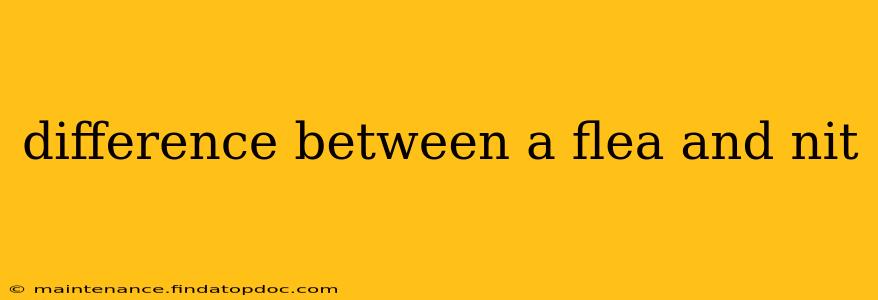Fleas and nits are both small parasites that can infest humans and animals, causing irritation and discomfort. However, they are vastly different creatures with distinct characteristics, life cycles, and habitats. Understanding these differences is crucial for effective identification and treatment.
What is a Flea?
A flea is a small, wingless insect belonging to the order Siphonaptera. They are parasitic, meaning they feed on the blood of their hosts, which can include mammals and birds. Fleas are laterally compressed, enabling them to move easily through fur or feathers. They possess strong legs, equipped with claws that allow them to cling tightly to their hosts.
Key Characteristics of Fleas:
- Size: Typically 1-3 mm long.
- Appearance: Dark brown or reddish-brown, laterally compressed bodies. They have strong legs and claws.
- Movement: Agile jumpers.
- Habitat: Live on their host's body and in bedding, carpets, and other areas where the host spends time.
- Bite: Fleas bite, causing itchy welts and potential allergic reactions in sensitive individuals.
What is a Nit?
A nit is the egg of a louse, a tiny parasitic insect. While both fleas and lice are parasites, they're completely different types of insects. Lice are wingless insects that live and feed on the blood of their host, typically clinging to hair shafts. Nits are small, oval-shaped, and firmly attached to hair strands.
Key Characteristics of Nits:
- Size: Tiny, about the size of a sesame seed.
- Appearance: Small, oval-shaped, pearly white or light brown eggs firmly attached to hair shafts near the scalp.
- Movement: Immobile; they are eggs.
- Habitat: Attached to hair strands, typically close to the scalp.
- Bite: Lice (not nits themselves) cause itching through biting and irritation of the scalp.
What are the key differences between fleas and nits?
| Feature | Flea | Nit |
|---|---|---|
| Type | Wingless insect | Louse egg |
| Size | 1-3 mm | About the size of a sesame seed |
| Appearance | Dark brown/reddish-brown, laterally compressed | Pearly white or light brown, oval-shaped |
| Movement | Agile jumper | Immobile |
| Location | On the host's body and in their environment | Attached to hair shafts near the scalp |
| Feeding | Blood-sucking parasite | Nits don't feed, lice do |
| Effect on Host | Itching, allergic reactions | Itching (caused by lice, not nits) |
How can I tell the difference between a flea and a nit?
The most significant differences lie in their size, location, and appearance. Fleas are much larger and can jump, while nits are tiny, immobile eggs firmly attached to hair. Fleas are found on the body and in the host's environment, while nits are found only on hair shafts near the scalp.
What should I do if I find fleas or nits?
Finding fleas requires a thorough cleaning of your home and pets, possibly including professional pest control. For nits, you'll need to treat for head lice. This typically involves special shampoos and combing to remove both nits and lice from the hair. Consult a doctor or pharmacist for appropriate treatment options. Early detection and treatment are crucial for managing both infestations.
Are fleas and nits dangerous?
While generally not life-threatening, both fleas and lice infestations can cause significant discomfort and itching. Severe infestations can lead to secondary skin infections due to scratching. In rare cases, fleas can transmit diseases. Therefore, prompt treatment is recommended.
This comprehensive guide should help differentiate between fleas and nits. Remember, if you are unsure, consult a healthcare professional for accurate identification and treatment advice.
